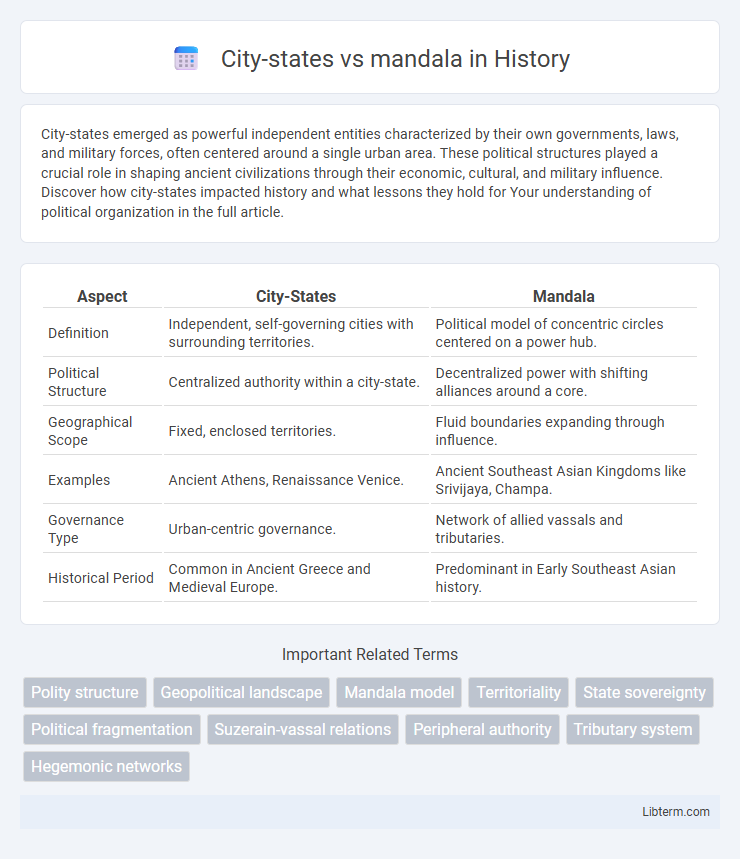City-states emerged as powerful independent entities characterized by their own governments, laws, and military forces, often centered around a single urban area. These political structures played a crucial role in shaping ancient civilizations through their economic, cultural, and military influence. Discover how city-states impacted history and what lessons they hold for Your understanding of political organization in the full article.
Table of Comparison
| Aspect | City-States | Mandala |
|---|---|---|
| Definition | Independent, self-governing cities with surrounding territories. | Political model of concentric circles centered on a power hub. |
| Political Structure | Centralized authority within a city-state. | Decentralized power with shifting alliances around a core. |
| Geographical Scope | Fixed, enclosed territories. | Fluid boundaries expanding through influence. |
| Examples | Ancient Athens, Renaissance Venice. | Ancient Southeast Asian Kingdoms like Srivijaya, Champa. |
| Governance Type | Urban-centric governance. | Network of allied vassals and tributaries. |
| Historical Period | Common in Ancient Greece and Medieval Europe. | Predominant in Early Southeast Asian history. |
Understanding City-States: Definition and Origins
City-states are independent political entities consisting of a city and its surrounding territory that maintain sovereignty and self-governance. Originating in ancient Mesopotamia, Greece, and Mesoamerica, city-states such as Athens, Ur, and Tikal functioned as centers of political, economic, and religious activity. These entities developed complex social structures and legal systems, distinguishing them from larger, territorially expansive empires or mandala polities.
The Mandala Model: Concepts and Historical Roots
The Mandala Model, rooted in Southeast Asian political history, emphasizes a flexible, concentric network of power centered around a dominant ruler, contrasting with the rigid territorial boundaries typical of city-states. This model illustrates how authority radiated outward through hierarchical relationships and alliances, rather than fixed borders, allowing for overlapping sovereignties and shifting allegiances. Its historical roots trace back to ancient Hindu-Buddhist kingdoms, where rulers maintained influence through tribute systems and strategic diplomacy.
Political Structures: Comparing Governance Systems
City-states feature centralized governance led by a single ruler or council, emphasizing territorial control and direct administrative authority. Mandala political structures incorporate a network of semi-autonomous centers with fluctuating influence, relying on diplomatic alliances and tribute rather than strict territorial dominance. These differing governance systems reflect contrasting approaches to power distribution, with city-states favoring hierarchical control and mandalas embracing decentralized, overlapping spheres of influence.
Geographic Organization of City-States vs Mandala
City-states are geographically organized around a defined urban center with clear territorial boundaries and centralized political control, often surrounded by rural hinterlands. Mandala systems, by contrast, feature a decentralized and fluid geographic organization with multiple, overlapping centers of power reflecting a concentric pattern of influence rather than fixed territorial borders. This spatial arrangement in mandalas emphasizes shifting alliances and tribute networks rather than strict jurisdictional governance typical of city-states.
Economic Systems and Trade Networks
City-states thrived on localized economic systems driven by trade specialization, controlling distinct trade routes and markets to accumulate wealth independently. Mandala systems featured decentralized economic networks where tributary states engaged in reciprocal trade and resource exchange within a fluid political structure. Trade networks in city-states were often formalized and regulated, while mandalas depended on flexible, negotiated economic relationships that adapted to changing power dynamics.
Cultural Identity and Influence
City-states often develop a strong cultural identity rooted in localized governance, economic independence, and unique social customs, fostering distinctive artistic and architectural styles that influence surrounding regions. Mandala systems, characterized by their concentric political organization, emphasize fluid cultural exchange and hierarchical alliances, allowing peripheral cultures to absorb and integrate elements from dominant centers. The interplay between city-states and mandalas shapes regional cultural landscapes through dynamic processes of identity assertion, diffusion, and syncretism.
Diplomacy, War, and Alliances
City-states operated as independent political entities with defined territorial boundaries, relying heavily on diplomacy to negotiate alliances and trade agreements for survival and expansion. Mandalas, characterized by loosely centered spheres of influence without fixed borders, employed fluid and strategic alliances with nearby polities to manage warfare and maintain a balance of power. Both systems emphasized flexible diplomacy and military alliances, but city-states prioritized formal treaties while mandalas adapted through shifting vassal relationships and tribute networks.
Evolution Over Time: Changes in Each System
City-states evolved from small, autonomous urban centers with defined territorial boundaries into more complex political entities that expanded influence through trade and military conquest. Mandala systems, characterized by a central power surrounded by semi-autonomous tributary states, gradually shifted as the central authority weakened, leading to fluctuating alliances and decentralized control. Over time, city-states tended to solidify sovereignty and institutional structures, whereas mandalas displayed a dynamic balance of power with variable boundaries shaped by diplomacy and conflict.
Lasting Legacies in Modern Politics
City-states like Athens and Venice pioneered self-governance and democratic institutions that influence modern political frameworks. The mandala model, prevalent in Southeast Asia, shaped regional diplomacy with its flexible power networks, inspiring contemporary federalism and alliance systems. Both frameworks contribute lasting legacies by demonstrating diverse approaches to governance and territorial control in today's political discourse.
Key Examples: Notable City-States and Mandala Polities
Athens and Venice stand out as notable city-states known for their independent governance and economic influence in classical Greece and Renaissance Italy respectively. The Srivijaya Empire and the Khmer Empire exemplify mandala polities, characterized by decentralized power radiating from a central ruler influencing surrounding tributary states in Southeast Asia. These examples highlight contrasting political structures where city-states emphasize autonomous urban centers while mandalas focus on fluid, expanding spheres of influence.
City-states Infographic

 libterm.com
libterm.com